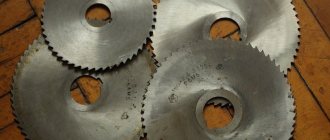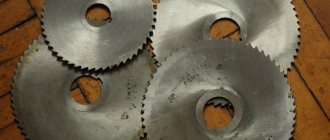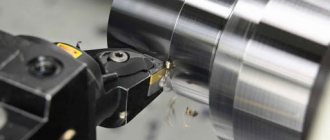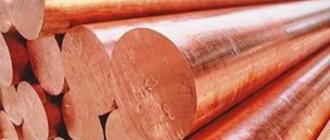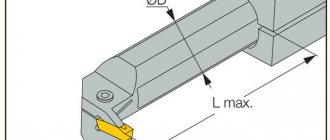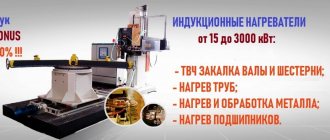Characteristics of high-speed steels
The category of high-speed steels includes alloys whose chemical composition is supplemented with a number of alloying additives.
Thanks to such additives, steels are given properties that allow them to be used for the manufacture of cutting tools that can operate efficiently at high speeds. What distinguishes high-speed alloys from conventional carbon alloys is that the tools that are made from them can be successfully used for processing hard materials at high speeds. Milling a part on a professional engraving machine
The most notable characteristics that distinguish high-speed steels of various grades include the following.
- Hardness maintained when hot (hot hardness). As is known, any tool used to perform cutting processing is intensely heated during such processing. As a result of heating, conventional tool steels are subjected to tempering, which ultimately leads to a decrease in the hardness of the tool. This does not happen if high-speed steel was used for manufacturing, which is capable of maintaining its hardness even when the tool is heated to 6000. Typically, high-speed steel grades, which are often called high-speed steels, have even lower hardness compared to conventional carbon steels if the cutting temperature is within normal limits: up to 2000.
- Increased red fastness. This parameter of any metal characterizes the period of time during which a tool made from it is able to withstand high temperatures without losing its original characteristics. High-speed steels as a material for the manufacture of cutting tools have no equal in this parameter.
- Resistance to destruction. A cutting tool, in addition to its ability to withstand exposure to elevated temperatures, must also have improved mechanical characteristics, which is fully demonstrated by high-speed steel grades. Tools made from such steels, which have high strength, can successfully operate at large depths of cut (drills) and at high feed rates (cutters, drills, etc.).
Characteristics and purpose of high-speed steels
Where are high speed steels used?
The scope of wear-resistant metal depends on the composition that determines its working properties. Basically, this is a tool that has high demands on strength, heat resistance, and long service life.
- Production of drills, cutters, cutters, taps;
- Manufacturing cutting edges for tools, which in some cases can be removable;
- Parts for metalworking machines and equipment;
- Manufacturing of tools used for finishing hard-to-cut metal products.
Experts give the following recommendations on the use of these metal grades:
- Tungsten-molybdenum compounds are suitable for tools intended for roughing products, manufacturing cutters, broaches and shaver.
- Cobalt compounds are used for processing heat-resistant and corrosion-resistant products in difficult conditions.
- Vanadium alloys are used for finishing materials.
- The P9 grade is used to create equipment elements that are not subject to excessive load.
- Grade P18 is suitable for tools with complex shapes and shaped products with increased wear resistance requirements.
The range of metal products is represented by square, circle, strip, and sheet metal. Most often, cutting tools are made from a circle. Square steel is used for the production of electric planers, knives, and turning tools. If you have doubts about the correct choice of a suitable alloy, it is better to contact specialists. Specialized companies will be able to select high-quality rental products with the required performance characteristics.
Manufacturing method R6M5
Of course, like any other alloy, R6M5 is manufactured in various assortments. So, in some workshops, high-speed hot steel is poured into ingots. At another production facility, it is hot rolled. To do this, heated ingots are compressed between the shafts of a rolling mill. Its resulting shape will depend on the shape of the shafts themselves.
Steel grade R6M5 is widely used for parts operating at high temperatures. For this reason, powder steel has become a very popular method of making steel lately.
When hot steel is poured into ingots, carbides are released very quickly from the melt. In some areas they form uneven areas of accumulation, which subsequently become the site of crack initiation.
In powder manufacturing, a special powder is used, which contains all the necessary components. It is sintered in a special vacuum container under high temperature and pressure. This helps ensure that the material is homogeneous.
Hardening steel for cutting tools
The main task of hardening is the dissolution of carbides in austenite. As a rule, tungsten and chromium-based carbides dissolve at 1200 °C; vanadium requires higher temperatures. After this stage, the structure has excess (those that have not dissolved) carbides. They inhibit grain growth. High temperatures produce fine-grained austenite. Cooling occurs in oil or molten salts. The temperature across the cross section of the part is equalized. This treatment of high-speed steel avoids the appearance of cracks. After hardening, the steel has the following structure: martensite, retained austenite, carbides.
Products that have found a place in everyday life and in production
R6M5 steel, its characteristics and application for knives. This is a fairly common household item; there are a number of its manufacturers with a global brand, for example, Rapid. There are many videos on the Internet with experiments using knives made of R6M5 steel. Indeed, they are good at cutting such things: ropes, wood, meat and bones, etc. The most striking experiment involved an attempt to cut a metal plate several mm thick with a R6M5 knife, and it worked.
Knife blanks made of steel R6M5 - this steel is very popular in everyday life
It should be added that high-speed steel R6M5 does not have a tendency for easy turning. Therefore, quite often knife owners complain about the inability to sharpen them. In any case, this cannot be done with household sharpeners. Apparently, this is why products made from P6M5 are rarely found in everyday life; they can more often be seen as an auxiliary tool among plumbing equipment or among avid fishermen and hunters.
In almost every home you can find household power tools. Auxiliary elements (equipment) for it can be made from quick cutters.
The P6M5 drill is used in the production of household tools intended for repair work. Additionally, there is an opinion that it is better to drill hardened iron using the R6M5K5 brand. In addition, there are the following types of drills:
simple with one-sided sharpening;
crown (for drywall);
stepped;
spear-shaped for glass and porcelain stoneware;
on stone, brick, wood.
Despite the above comment, the P6M5 metal drill is also a fairly common tool. R6M5 is used to make countersinks, crowns, conical machine reamers, drills, slotting cutters, and hacksaw blades.
Video - How to make a knife from P6M5 with your own hands
Alloy Application
The positive characteristics of this alloy helped to find the use of this steel in household use.
Knives are made from it. Moreover, if the product is sharpened correctly, it will be able to cut not only the flesh of an animal, but also a thin metal plate. Discs made of steel R6M5
The only disadvantage of this product is its sharpening. But, if you know all the tricks of proper sharpening, then this tool will become very useful in everyday life. These products are most often used by hunters and tourists.
Despite the expensive cost, the use of alloy for knives has become very popular in everyday life.
Every man in his house has a power tool, in which drills made of this type of steel are used as auxiliary equipment. The varieties of drills that are made from this R5M6 steel include:
- crown ones, which are used for drywall;
- stepped;
- drills designed for stone, wood or metal.
Not only drills and knives are made from this material. Slotting cutters, hacksaw blades, and countersinks are made from R6M5 steel.
Difficulties in hardening high-speed steel
Heat treatment of P6M5 contains a number of specific features associated with the characteristics of this brand, as well as a long heating time for hardening. To reach 1230 degrees Celsius (hardening temperature according to GOST), 25 percent more working time is spent than for a similar grade P18. First, a vacation period is made at 200 and 300 degrees for an hour. Further processing is carried out in 3 stages:
- 690 degrees -3 minutes;
- 860 – also 3 minutes;
- 1230 – 1.5 minutes.
Then the steel is cooled. In further processing, a three-time vacation period at 560 degrees for 1.5 hours is used. During tempering periods, the alloy is supplemented with alloying additives that form carbides, which increases the strength of the final metal. Previous annealing of steel helps eliminate high brittleness with a high strength index.
Heat treatment of R6M5 steel
Heat treatment of the R6M5 alloy has a number of subtleties that relate to its properties. The fact is that it is capable of decarbonization during heating. To prevent this from happening, it is usually heated using a slow simmer.
Hardening
R6M5 high-speed steel heats up to 1230 degrees. During heating, steel mill workers closely monitor the process. During the first warm-up, the temperature rises to two hundred degrees and the heating stops for an hour, then another additional heating is performed to thirty degrees. And again a vacation for an hour. After this, it is continued to be heated to 690 degrees and stopped again for an hour. And the last two heatings are brought to temperatures of 860 and 1230, respectively.
This is a very complex incandescent procedure. Thanks to such hardening, the alloy acquires properties corresponding to it, but its cost, of course, increases.
After heating to 1230 degrees is completed, it is cooled using saltpeter, air and oil. Then, the temperature drops to 560 degrees. This temperature is maintained for one and a half hours. At this time, various alloying elements are added to the steel, which improve its properties. They also give it the appropriate hardness.
Before such long heating begins, the metal alloy is annealed. This is done in order to reduce the fragility of future products while maintaining strength parameters at the proper level.
To improve the characteristics of the properties of this alloy, so that they have good wear resistance, corrosion resistance, and high hardness, nitriding is used. This metal processing is carried out in a gas environment that consists of 80 percent nitrogen and twenty percent ammonia. The time this procedure takes is about forty minutes. The heating temperature will range from 550 degrees to 6600. This hardening will allow the alloy to form a less brittle surface layer.
Such an alloy can be supplemented with another element, namely zinc. Galvanizing occurs in a gas or liquid environment that contains a large amount of zinc. The heating temperature in it corresponds to 5600 degrees. And the time is about thirty minutes.
Buying and selling quick cutters
Do you need a reliable supplier of high-quality high-speed steel? It offers its services, operating in Lyubertsy. We offer cooperation on the most favorable terms.
Our services
High-speed steels are widely used in the production of cutting tools. If you are looking for where to buy quick cutters P6M5 P18, etc., we can offer a wide range of rolled metal products of this type. Our assortment includes the following brands:
- P18 is a universal option, suitable for the manufacture of cutting tools of various types;
- R6M5 is a brand perfectly suitable for the production of thread-cutting tools;
- R6M5K5 is the best choice if you need to produce rough and semi-rough tools;
- other brands (R9K5, R6M5F3, R18F2, R18F2K8M, R9K5, R9M4K8, R12F2K8M3, etc.);
- tool steels of the following grades: (9ХС, ХВГ, 95Х18, Х12МФ, Х12М, Х12Ф1, 4Х5МФС,
- 3Х2В8Ф, 5ХНМ, 3Х3М3Ф, 4Х5В2ФС, 4Х4ВМФС, (DI22), 6ХВ2С, 5ХВ2С, Х6ВФ), etc.
Rolled metal is supplied in the form of:
- sheets;
- stripes;
- circles;
- squares.
Sales of high-speed steels are not the only area of our activity. The scope also includes:
- steel purchase. By contacting us, you can sell quick cutters P6M5 P18, etc., as well as tool steels of various grades;
- chemical analysis of the composition of metals and alloys. Our specialists travel within Moscow and the surrounding Moscow region. To perform the analysis, a modern portable XRF analyzer DELTA (OLYMPUS) is used, which makes it possible to obtain the most accurate information about the composition of the samples.
Why ZIRCON LLC?
ZIRCON LLC has been operating in the high-speed steel market since 2009. During its work, the company has excellently established itself as a conscientious supplier, which can offer customers a number of important advantages:
- high quality rolled metal. Quick cutters must undergo strict quality control. It meets the requirements of GOST 19265-73 and TU;
- optimal prices. Our company has the ability to deliver from State Reserve bases, making the cost of rolled metal as profitable as possible. Special conditions and special offers apply to regular suppliers;
- large warehouse. Rental is sold from a warehouse located in Lyubertsy. ZIRCON LLC can guarantee its availability and prompt daily updating of the list of warehouse balances on the website.
By contacting us, you will acquire an executive supplier who will never let you down!
Characteristics of high-speed steels
Hot hardness
At normal temperatures, the hardness of carbon steel is even slightly higher than the hardness of high-speed steel. However, during operation of the cutting tool, intense heat is generated. In this case, up to 80% of the released heat is spent on heating the instrument. Due to an increase in the temperature of the cutting edge, the tool material begins to temper and its hardness decreases.
After heating to 200 °C, the hardness of carbon steel begins to rapidly decrease. For this steel, a cutting mode in which the tool would heat up above 200 °C is unacceptable. High-speed steel retains its high hardness when heated to 500–600 °C. High speed steel tools are more productive than carbon steel tools.
Red fastness
If hot hardness characterizes what temperature steel can withstand, then red hardness characterizes how long the steel will withstand such a temperature. That is, how long will quenched and tempered steel resist softening when heated.
There are several characteristics of red fastness. Let's give two of them.
The first characteristic shows what hardness the steel will have after tempering at a certain temperature for a given time.
The second way to characterize red hardness is based on the fact that the intensity of the decrease in hot hardness can be measured not only at high temperature, but also at room temperature, since the hardness decrease curves at high temperature and room temperature are equidistant, and measuring hardness at room temperature, of course, is much easier than at high. Experiments have shown that cutting properties are lost at a hardness of 50 HRC at cutting temperature, which corresponds to approximately 58 HRC at room temperature. Hence, red hardness is characterized by a tempering temperature at which in 4 hours the hardness decreases to 58 HRC (designation K4р58). Characteristics of heat resistance of carbon and red resistance of high-speed tool steels
| steel grade | Temperature, °C | Exposure time, hour | Hardness, HRCе |
| U7, U8, U10, U12 | 150—160 | 1 | 63 |
| P9 | 580 | 4 | |
| U7, U8, U10, U12 | 200—220 | 1 | 59 |
| R6M5K5, R9, R9M4K8, R18 | 620—630 | 4 |
Fracture Resistance
In addition to “hot” properties, high mechanical properties are also required from the cutting tool material; This means resistance to brittle fracture, since at high hardness (more than 60 HRC) fracture always occurs by a brittle mechanism. The strength of such high-hard materials is usually defined as the resistance to fracture during bending of prismatic, uncut specimens under static (slow) and dynamic (fast) loading. The higher the strength, the greater the force the working part of the tool can withstand, the greater the feed and depth of cut that can be applied, and this increases the productivity of the cutting process.
Chemical composition of high-speed steels
Chemical composition of some high-speed steels
| steel grade | C | Cr | W | Mo | V | Co |
| Р0М2Ф3 | 1,10—1,25 | 3,8—4,6 | — | 2,3—2,9 | 2,6—3,3 | — |
| R6M5 | 0,82—0,90 | 3,8—4,4 | 5,5—6,5 | 4,8—5,3 | 1,7—2,1 | < 0,50 |
| R6M5F2K8 | 0,95—1,05 | 3,8—4,4 | 5,5—6,6 | 4,6—5,2 | 1,8—2,4 | 7,5—8,5 |
| P9 | 0,85—0,95 | 3,8—4,4 | 8,5—10,0 | < 1,0 | 2,0—2,6 | — |
| P18 | 0,73—0,83 | 3,8—4,4 | 17,0—18,5 | < 1,0 | 1,0—1,4 | < 0,50 |
Violation of heat treatment technology
A decrease in the amount of carbon on the surface of the workpiece may be a consequence of poor deoxidation of the salt bath, as well as overheating during austenitization. Exceeding the temperature leads to melting of the grain boundaries. Also, the processed part may have cracks. This phenomenon occurs due to the rapid heating of the metal. Another reason is accelerated cooling. A low hardness value may be a consequence of insufficient alloying of the martensite structure, a violation of the temperature regime during tempering, at which retained austenite remains. Another possible defect in the workpiece is mothball fracture.
How to make a knife from rapid with your own hands
Steel grades: P10, P12, P14, P18 and the P6M5 family are excellent for creating cutting elements. The fragility of saw blades is somewhat exaggerated.
You should not make blades that are too long and use them to dig into sewer manholes. There will be no problems with the knife in future use.
Rapid alloy is quite resistant to loads and is designed for long-term loads. Proper manufacturing of the blade guarantees all its available qualities. We will give brief instructions on how to make a blade with your own hands from common steel grade R6M5.
Homemade knife from a quick cutter.
Required materials and tools
The alloy is quite resistant to mechanical stress. Difficulties during production will definitely arise; it is not appropriate for a Russian master to be afraid of them. Materials needed:
- wooden block and epoxy glue (for the handle);
- a piece of brass, bronze or copper;
- impregnating varnish, oil.
Hacksaw blade steel grade R6M5 - blank. Protective glasses and gloves; the work ahead will be dusty and labor-intensive. Toolkit of the following type:
- Grinder angle grinder, set of discs for various purposes;
- vice, hammer, jigsaw, files, pliers;
- sharpening machine, wheels for it with different grains;
- needle file, drill and set of drills;
- marker, sandpaper, clamp;
- container with water.
A horse-drawn handle is ideal. The choice to stop is on her.
Manufacturing of the main profile
You should not use a template; it is better to draw with a marker on the canvas itself. The specific qualities of the steel will allow you to make cuts in accordance with the image. And use pliers to break off pieces of steel along the cut. The drawing is carried out together with the shank.
At the end of the process, we will obtain a rough, rough blade blank. We refine the part on a grinding machine. We remove excess metal by grinding on a coarse-grit wheel. The grooves on the shank will help with better bonding to the wood.
Bevels and grinding of the blade
We mark out the symmetrical bevels; the process is quite important and should be handled with care. We try to prevent overheating; periodically dip the blade in water. A special device will help to make clear descents.
Polishing a knife blade.
The grinding machine wheel needs to be changed; the finest grain is used. After making sure that the slopes are symmetrical, it is permissible to carry out the initial sharpening of the workpiece. Final sanding is done manually using sandpaper.
Along the way, we make a bolster, a suitable piece of brass, and mark it for the blade. In accordance with the markings, it is necessary to drill small holes. Then widen them using a file to insert the blade.
Making the handle
The saw workpiece must be wrapped with tape to continue safe work. The wooden block should be marked and holes should be drilled in it in accordance with the shank. Try it on together with the bolster.
Does it fit perfectly? Go ahead:
- You can start gluing the parts. It is recommended to mix epoxy with wood shavings. Fill the hole of the future handle with glue, insert the bolster and blade. We strengthen the structure with a clamp. Let the glue dry for a day.
- Once dry, release the workpiece. We mark the future handle and remove the excess with a jigsaw. The rough version of the handle is ready.
- We bring it to an anatomical or other shape using sandpaper. We process the finest grains in conclusion.
We soak the handle with oil or a special liquid. This will give the product water-repellent qualities and less susceptibility to rotting. All that remains is to sharpen the blade according to all the rules.
Price for steel R6M5
The cost of the R6M5 is quite high. So, in Moscow, a circle with a thickness of 2 mm costs 1,350 rubles per kilogram, and a circle with a thickness of 16 mm, its price will be 600 rubles per kilogram. For comparison, ordinary carbon steel costs between 20 and 40 rubles per kilogram.
It is the high cost of the high-speed cutter that encourages enterprises that use it in their work to collect its waste and hand it over to the appropriate organizations. Then, R6M5 is sent for remelting and a new tool is made.
A little history
R6M5 steel owes its origin to the next industrial revolution that took place in Britain. In the middle of the 19th century, the issue of processing steels and alloys became acute. The cutting tool that existed at that time quickly heated up and the quality of processing was reduced to zero. As a result of research conducted by the English steelmaker R. Muschet, steel was tested that contained carbon, tungsten, manganese and other alloying additives in its chemical composition.
Almost half a century later, American metallurgists created steel, which became the prototype of the modern P18 high-speed cutter. Around the same time, the R6M5 steel recipe was formed.
It must be said that the appearance of a quick cutter served as the basis for a significant increase in productivity in metalworking.
Rating: 5/5 – 4 votes
Cost of metal in products
It is not difficult to buy R6M5 in finished products, but the cost of the alloy is quite high. Here is a small price list of steel products of this brand. So a tool circle, depending on the thickness: 2, 5 or 16 mm, costs 1350, 1200, 600 rubles per kilogram, respectively. The cost of an instrumental strip is slightly lower and amounts to 620 rubles per kilogram.
Undoubtedly, prices for R6M5 grade metal in products may vary, so the given figures should be taken relatively, only to determine the level of cost of the alloy. On the other hand, high prices for quick cutters make the metal quite popular in the sale of scrap metal (see quick cutter scrap). The cost of secondary high-speed steel is significantly higher than that of conventional metal grades. Alternatively, products made from R6M5 alloy, which have served their service life, can be used as business scrap, with a higher value.
Steel R6M5 – decoding of steel grade, GOST, material characteristics
Steel grade – R6M5
Standard – GOST 19256
Steel grade R6M5
The first letter
P
means that the steel is high-speed.
6
following the letter indicates the average mass fraction of tungsten (6%),
M5
indicates the molybdenum content in the steel of approximately 5%. Alloy steel, high-speed.
High-speed steel R6M5 is used for the manufacture of all types of cutting tools when processing carbon alloy structural steels, preferably for the manufacture of thread-cutting tools, as well as tools working with shock loads.
| Mass fraction of basic chemical elements, % | ||||||
| C – carbon | Si – silicon | Mn – manganese | Cr – chromium | W – tungsten | Mo – molybdenum | V – vanadium |
| 0,82-0,90 | 0,20-0,50 | 0,20-0,50 | 3,80-4,40 | 5,50-6,50 | 4,80-5,30 | 1,70-2,10 |
| Temperature of critical points, °C | |||
| Ac1 | Ac3 | Ar1 | Ar3 |
| 815 | 880 | 730 | 790 |
| Technological properties | |
| Forging | Forging temperature, °C: beginning 1160, end 850. Slow cooling in the well. |
| Weldability | Not applicable for welded structures. |
| Machinability | Annealed at HB 255: Kv carbide = 0.8 Kv high speed steel = 0.6 |
| Flokensensibility. | Not sensitive |
| Sandability | good |
The most common grades of high-speed steel
High-speed steel (GOST 19265-73) is divided into alloys of normal and increased heat resistance. The first group includes brands such as P18, P6M5. Their hardness reaches 63 HRC. Their main purpose is the processing of cast iron, copper, and aluminum alloys. Tungsten steels have higher heat resistance. They are used for the manufacture of drills, cutters, and cutters. R6M5 steel, which contains molybdenum, is slightly inferior in cutting properties, but it is significantly cheaper. In addition, its ductility is somewhat higher, and its tendency to crack formation is not so high. More heat-resistant steels contain vanadium and cobalt (10Р6М5, Р9Ф5). Their hardness reaches 66 HRC. They are used for processing stronger structural steels, heat-resistant alloys, and in the manufacture of finishing tools. It is characteristic that these brands have higher wear resistance (due to the presence of vanadium in the composition). Recently, the method of powder metallurgy has been increasingly used. Such tools have higher cutting properties.
Straight turning cutting cutters made of high-speed steel (P18) TU 2-035-491-76
| Lathe scoring cutter straight 6x6x50 | 430 rub. Buy |
| Lathe scoring cutter straight 6x6x80 | 450 rub. Buy |
| Lathe scoring cutter straight 8x8x50 | 410 rub. Buy |
| Lathe scoring cutter straight 8x8x80 | 430 rub. Buy |
| Lathe scoring cutter straight 8x8x100 | 460 rub. Buy |
| Lathe scoring cutter straight 10x10x60 | 390 rub. Buy |
| Lathe scoring cutter straight 10x10x100 | 450 rub. Buy |
| Lathe scoring cutter straight 10x10x120 | 480 rub. Buy |
| Lathe scoring cutter straight 12x12x70 | 470 rub. Buy |
| Lathe scoring cutter straight 12x12x100 | 630 rub. Buy |
| Lathe scoring cutter straight 12x12x120 | 690 rub. Buy |
| Lathe scoring cutter straight 16x16x80 | 820 rub. Buy |
| Lathe scoring cutter straight 16x16x100 | 1020 rub. Buy |
| Lathe scoring cutter straight 16x16x150 | 1680 rub. Buy |
The influence of alloy elements on the properties of steel
High heat resistance of high-speed steel grades is provided by tungsten and molybdenum. On their basis, carbides are formed, which partially pass into solid solution. After heat treatment, the martensite structure is ensured. Tungsten, molybdenum, and vanadium slow down its decomposition. This is what provides the necessary red fastness. For a long time, high-speed steel alloyed only with tungsten was used. However, due to the scarcity of this metal, they began to partially replace it with molybdenum. This element also has a positive effect on the tendency of tungsten steel grades to carbide heterogeneity. Vanadium forms the hardest carbide. However, the carbon content must be sufficient for greater saturation of the solid solution. The more vanadium is introduced, the more carbon there should be in the alloy. The main task of chromium is to impart high hardenability to steel. Cobalt also increases red resistance.
High-speed steel (hardness when alloyed with this element increases to 70 HRC) in this case will have reduced strength. It is worth noting that the introduction of chromium is not widely used due to the high cost of the element.
Steel marking
High-speed steel is marked with the letter P, which is placed in front. The main alloying elements are tungsten and chromium. Elements such as vanadium and molybdenum are also additionally introduced. The number after the letter P indicates the percentage of tungsten in the steel. Typically, high-speed steel contains about 4% chromium. This element is not indicated in the labeling. If the numbers appear before the letter P, then they indicate the percentage of carbon (for example, steel 11Р3АМ3Ф2 contains 1.1% carbon). Basically, the steels of this group are highly alloyed.
OTHER MATERIALS USED IN THE PRODUCTION OF KNIVES (EXCEPT STEEL):
Cobalt-Stellite 6K. This is a flexible material with very high wear resistance, most often resistant to corrosion. Stellite 6K is a cobalt alloy. David Boye uses cobalt to make submariner knives. Titanium. The latest titanium alloys can have a hardness of up to 50 units, and this allows them to be used for the manufacture of cutting parts. Titanium is incredibly resistant to corrosion and is also non-magnetizable. Widely used in expensive submarine knives due to the fact that military marines use it to work with mines that detonate when metal approaches. Titanium is also used in survival knives. Tygrys produces knives with a steel core covered with layers of titanium. Ceramics. The blade on some knives is actually made of ceramic. Most often, these blades are very fragile and cannot be sharpened on their own. However, they hold the factory sharpening well. Such knives are made by Boker and Kyocera companies. Kevin McClung recently released a composite knife using ceramic that is much more durable than other ceramic knives and is quite suitable for most general jobs, and can also be sharpened at home and still holds an edge well.
Steel R6M5K5 – Vladresurs company
| Brand: | R6M5K5 |
| Classification: | High-speed tool steel |
| Addition: | The steel has an increased tendency to decarburization, good toughness, increased wear resistance, and good grindability Products offered by advertisers: No data. |
Chemical composition in % of the material R6M5K5
GOST 19265 – 73
| C | Si | Mn | Ni | S | P | Cr | Mo | W | V | Co | Cu |
| 0.86 – 0.94 | 0.2 – 0.5 | 0.2 – 0.5 | up to 0.6 | up to 0.03 | up to 0.03 | 3.8 – 4.3 | 4.8 – 5.3 | 5.7 – 6.7 | 1.7 – 2.1 | 4.7 – 5.2 | up to 0.25 |
Temperature of critical points of the material R6M5K5.
| Ac1 = 840, Ac3(Acm) = 875, Ar3(Arcm) = 805, Ar1 = 765 |
Mechanical properties at T=20oC of the material R6M5K5.
| Assortment | Size | Eg. | sв | sT | d5 | y | KCU | Thermal change |
| – | mm | – | MPa | MPa | % | % | kJ/m2 | – |
| 850 | 510 | 12 | 14 | 180 | Delivery status |
| Hardness Р6М5К5 after annealing, GOST 19265-73 | HB 10 -1 = 269 MPa |
Physical properties of the material R6M5K5.
| T | E 10- 5 | a 10 6 | l | r | C | R 10 9 |
| hail | MPa | 1/Grad | W/(m deg) | kg/m3 | J/(kg deg) | Ohm m |
| 20 | 2.2 | 8200 | 458 | |||
| 100 | 27 | |||||
| 200 | 28 | |||||
| 300 | 29 | |||||
| 400 | 30 | |||||
| 500 | 32 | |||||
| 600 | 36 | |||||
| 700 | 34 | |||||
| 800 | ||||||
| 900 | 29 | |||||
| T | E 10- 5 | a 10 6 | l | r | C | R 10 9 |
Foreign analogues of the material R6M5K5
Attention! Both exact and closest analogues are indicated
| USA | Germany | Japan | France | England | European Union | Italy | Spain | China | Sweden | Bulgaria | Hungary | Poland | Czech | Austria | South Korea | ||||||||||||||||
| – | DIN,WNr | JIS | AFNOR | B.S. | EN | UNI | UNE | G.B. | SS | BDS | MSZ | PN | CSN | ONORM | KS | ||||||||||||||||
|
Types of HSS steels
HSS steels come in three categories:
- tungsten (T1-T15);
- molybdenum (M1-M36);
- highly alloyed (M41-M62).
The most commonly used grade is T1 and the alloy with the addition of cobalt and vanadium T15. T15 steel is used to produce tools that are needed to work at high temperatures and increased wear.
Tungsten steels
Not the most popular variety. This is due to the fact that tungsten is quite rare and expensive. The most common grades of tungsten steel are T1 and T15. The second contains cobalt and vanadium, therefore they are suitable for the production of accessories that have increased requirements for strength and resistance to high temperatures.
Molybdenum HSS drills
The main alloying component of steels in this group is molybdenum. Also in different quantities may contain:
- tungsten,
- cobalt;
- vanadium;
- carbon;
- and other components.
The most widely used are HSS drills made from the following types of molybdenum high-speed steels.
- M1. General purpose tools are produced from this grade of steel (8% molybdenum). These HSS drills are highly flexible and resistant to impact loads. Red fastness is lower than that of analogues.
- M2 (domestic equivalent - P6M5). This is the most common material for the production of HSS drills. The alloy contains 6% tungsten and 5% molybdenum. It has balanced strength, hardness and heat resistance.
- M3 (domestic equivalent - R6M5F3). This alloy also contains 3% vanadium. HSS drills made from this steel have lower abrasive wear.
- M7. The main alloying components are molybdenum (8.75%), vanadium (2%) and tungsten (1.75%). Drills made from this HSS steel are used for drilling hard and thick sheet metals.
- M35 (domestic equivalent - R6M5K5). In addition to tungsten, molybdenum and vanadium, this alloy contains cobalt (5%), as well as small amounts of manganese, silicon and nickel. The advantages of this material are good toughness, excellent grindability, heat and wear resistance. HSS drills made from this alloy are used when processing workpieces made of improved alloy and stainless steels under conditions of increased heating of the cutting edge.
High alloy HSS drills
To produce high-alloy HSS drills (having high impact strength and operating in cold conditions), molybdenum group alloys are used, which are subjected to special heat treatment.
- M47 (domestic analogue - R2AM9K5). Contains large quantities of molybdenum (9%) and cobalt (4.7–5.2%). The alloy has an increased tendency to decarburization and overheating during quenching. Sandability is low. HSS drills made from this alloy are used for machining workpieces made of improved alloy and stainless steels.
- M42. Contains a large amount of cobalt and molybdenum (8 and 9.5%, respectively). HSS drills made from this alloy are characterized by increased red hardness and abrasion resistance. Such tools are used when processing viscous and complex metals.
This is interesting: Design, operating principle and circuit diagram of a welding inverter. Types and classifications
Peculiarities
Steel grades R6M5 and R18 are used not only in the manufacture of knives, but also in the production of taps, drills, and industrial cutting tools. They are distinguished by their ability to maintain hardness and sharpness when exposed to high temperatures and significant shock loads. The high content of carbon and tungsten in the composition gives steel these characteristics.
Heat treatment
To give knives made from P18 and P6M5 increased strength and wear resistance, the metal is subjected to appropriate heat treatment. It takes place in 2 stages:
- Hardening – heating to a temperature of 1200-1300C. To avoid the formation of cracks, it is carried out gradually. First, the metal is heated to a temperature of 400-500C, then to a temperature of 800-850C. At maximum heating, the workpiece is subjected to heat treatment for a limited time (10-15 seconds for each millimeter of thickness). During hardening, the carbide decomposes, the alloy is saturated with tungsten and carbon.
- Vacation is carried out at a temperature of 550-560C. It is carried out in 2-3 stages, each lasting at least an hour. At the same time, the strength characteristics of the metal increase.
Steel is heated in special salt baths, which consist of barium chloride (78%) and sodium chloride (22%). Magnesium fluoride is used to deoxidize the solution.
Production of cutting tools
After heat treatment of the steel, the production of cutting tools begins. For this purpose, the workpieces, which are previously checked for compliance with GOST requirements, are sent for grinding. Products made from P18 steel are easier to grind, but they also retain their sharpness for a shorter period of time. Knives made from R6M5 alloy can only be sharpened with professional tools and skills, but their sharpening quality is much better. In production, specialized machines are used for grinding workpieces made of steel R18 and R6M5.
Knife Grif steel P18, birch bark handle.
Use in cutting
Knives made of steel P18 and P6M5 are quick-cutting and universal in use. The metal performs well under heat and mechanical stress. It does not lose strength or deform. Manufacturers of knives made from these steel grades conducted experiments during which they successfully coped not only with slicing various food products (meat, bones, cartilage), but also with cutting wood and even metal plates several millimeters thick!
Annealing
As a rule, the production of such an alloy is classical and can be used for all high-speed steels. However, it should be borne in mind that in order for the tungsten-molybdenum alloy to be truly strong, hard and wear-resistant, it must be annealed.
If other grades, for example, St45, lose their strength properties during annealing, then high-speed grades, on the contrary, improve and become stronger and harder. That is why R6M5 is annealed before hardening. How does this happen?
Rolled products (for example, R6M5 steel sheet) with a thickness of about 22 mm are heated in a special furnace to a temperature of 870 °C, then cooled to 800 °C, and then heated again. There can be about 10 such cycles.
In addition, after the fifth, it is necessary to gradually reduce the temperature. For example, after heating again to 850 °C, cool to 780 °C. And so on until it reaches 600 °C.
This complex annealing process is explained by the presence of austenite grains in alloyed alloys, which is extremely undesirable. Heating and cooling allows the alloying elements to be dissolved as much as possible, but austenite will not grow.
If the temperature regime is not maintained and annealing is performed at temperatures above 900 °C, then an increased amount of austenite will form in the alloy and the hardness will decrease. Cooling is recommended to be carried out using oil baths; this will protect the tungsten-molybdenum alloy from cracks and chips.
Characteristics of steel
The main properties of this steel grade include increased toughness, good wear resistance and acceptable grindability. Has an increased tendency to decarbonization. This allows this metal to be used for all types of cutting tools sharpened for processing alloyed carbon structural products, in particular, shot blasting.
The tungsten-molybdenum series retains its properties at high temperatures. The bending strength is 4700 megapascals. The superiority in thermoplasticity and toughness is about 50 percent.
Another undeniable advantage of this brand is the ability to hold an edge. For this it is better to use a quick cutter. Excellent performance against impact loads makes it relevant in terms of use for creating drills, reamers and taps.
Decoding - what do the marking symbols mean?
What is the meaning of the abbreviation R6M5 - spelling out steel? Such designations turned out to be a legacy of Soviet times.
The letter "P" is a designation for high-speed steels. The word is taken from the transcription of the English “rapid”, translated as “fast”.
The number behind the letter “P” indicates the percentage of tungsten in the alloy. For the brand described, it fluctuates around 6% with minor deviations.
Next comes the letter “M”, indicating the presence of molybdenum in the alloy. The next parameter is the proportion of the substance present in the composition.
In addition to Mo, high-speed steels may contain the following designations in their markings: “K” - cobalt, “F” - vanadium, “T” - titanium, “C” - zirconium.
Analyzing further the abbreviation P6M5, the decoding of steel may include additional letters. If the metal is produced by electroslag remelting, the nomenclature “Ш” (Р6М5-Ш) appears. With the introduction of new P6M5 technologies, decoding began to be found in this interpretation, P6AM5. This means alloying with nitrogen, which occurs at the stage of cooling the alloy after heating it to the hardening temperature (more details below). This steel is used in the manufacture of milling wheels.
Drill from Japanese company Nachi made of HSS steel
Imported analogues of high-speed cutters are labeled as HSS, which means High Speed Steel, literally translated, this is high-speed steel, and analogues of P6M5 are steels:
1.3343 (Germany DIN);
S600/S601 (standard D-016);
M2 (USA according to AISI/ASTM standards).
Analogs
The Russian steel grade R6M5 has analogues in various countries. All of them are marked HSS, which stands for High Speed Steel. And in translation this means high-speed steel. Domestic analogues are: R12, R10K5F5, R18.
But these alloys contain a high percentage of tungsten, which increases their cost in the market. Foreign analogues are comparable in price to R6M5 steel. Here are some examples of labels in different countries:
- Japanese – SKH51;
- American – T11302, M2;
- English – 3343, BM2;
- French – HS6-5-2, HS6-5-2HC, X85WMoCrV6-5-4, Z85WDCV;
- German – HS6-5-2, S6-5-2, S6-5-2S, SC6-5-2;
- Polish – SW7M;
- China – W6Mo5Cr4V2;
- Italian - HS6-5-2, X82WMoV6-5.
Improving product performance
Tools made from high-speed cutters are subject to high demands, and in order for them to meet them to the fullest, their surface is processed. Various methods are used for this, including:
- The surface layer of the part is subjected to nitriding. Such treatment can be carried out in a gaseous environment consisting of either 80% nitrogen and 20% ammonia, or 100% ammonia. The process takes 10-40 minutes at a temperature of 550 - 6600 degrees. This operation makes the top layer less fragile.
- The surface is saturated with carbon and nitrogen - the so-called cyanidation, which occurs by immersing the part in molten sodium cyanide. Depending on the final purpose of the part, cyanidation takes place at different temperatures. The longer the time and the higher the temperature, the thicker the layer becomes.
- Sulfidation is performed in a liquid sulfide melt with the addition of sulfur. This process is carried out from 45 minutes to 3 hours at temperatures from 450 to 5600 degrees Celsius
All of the above procedures are performed with a ready-made tool: the cutting part is sharpened, the surface is polished and hardened.
High speed steel knife.
Average holiday
Average tempering is carried out at temperatures of 350–400 °C. In this case, all excess carbon is released from martensite with the formation of cementite particles. The tetragonality (degree of tetragonality) of the iron lattice decreases, it becomes cubic. As a result, ferrite remains instead of martensite. Such a ferrite-cementite mixture is called tempering troostite, and the process leading to such changes is called medium-temperature tempering. With medium tempering, the dislocation density decreases and the internal stresses in the steel decrease.
Medium tempering is used for heat treatment of elastic parts: leaf springs, springs, etc.
Chemical composition
The chemical composition of R6M5 includes, in addition to the carbon and molybdenum listed above, the following components:
- carbon (C) 0.82 – 0.90%;
- manganese (Mn) 0.20 – 0.50%;
- chromium (Cr) 3.8 – 4.4%;
- silicon (Si) 0.20 – 0.50%;
- molybdenum (Mo) 4.8 – 5.3%;
- vanadium (V) 1.7 – 2.1%;
- cobalt (Co) 0.5%;
- nickel (Ni) 0.4%;
- phosphorus (P) 0.03%;
- sulfur (S) 0.025%;
- tungsten (W) 5.5 – 6.5%.
An alloy with cobalt additives has been used since the beginning of the twentieth century. It is used to produce devices for cutting acid-resistant metals that are resistant to high temperatures. Processing such metals with devices from a different brand requires additional costs. This steel is characterized by high hardness and heat resistance.
Main characteristics
The basic parameters of steel of this grade are: high toughness, excellent wear resistance, and a good level of grindability. This grade is used in the production of many types of blades and cutting equipment for working with structural strength steels.
Knife with a blade made of steel R6M5.
A tungsten-molybdenum alloy is the second name of this brand, which can retain its characteristic qualities even under extreme temperature changes. Moreover, its bending strength reaches 4700 MPa. Its combination with impact strength gives it a noticeable superiority over many of its peers.

